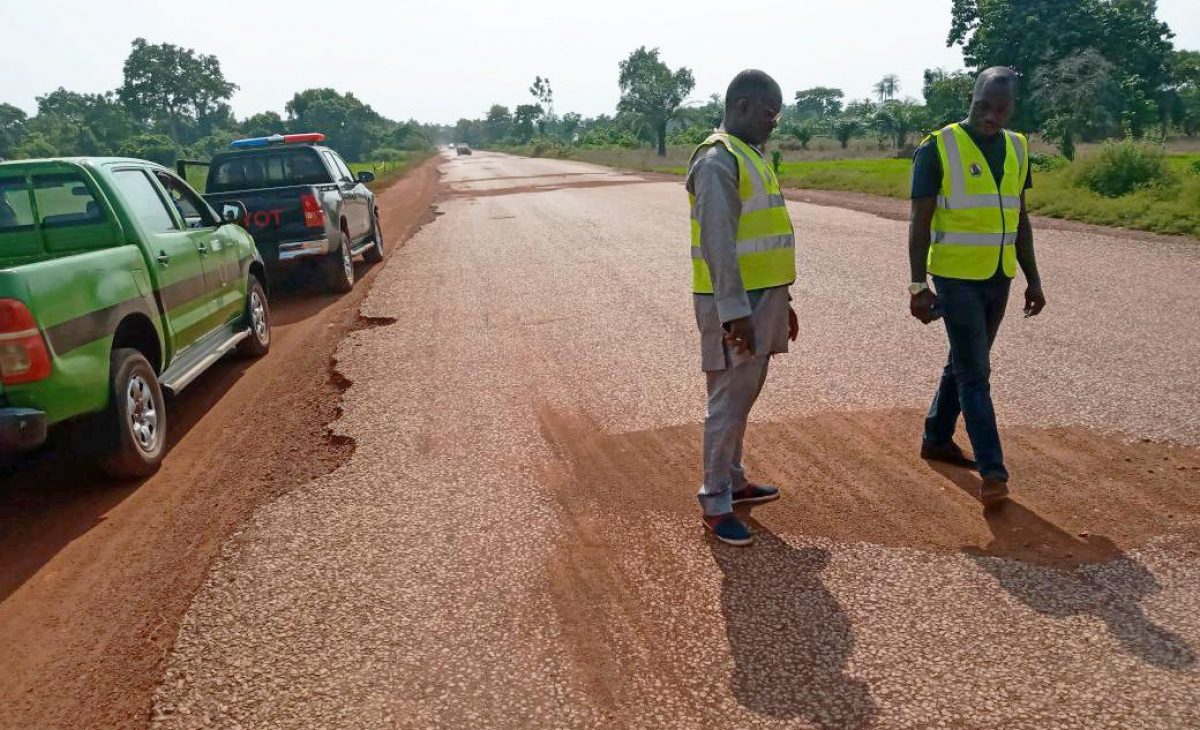Despite changes, pivots, and budget cuts UKNIAF’s Roads component consistently delivered its strategy through three workstreams: Roads Asset Management System (RAMS), Reform, and Project Delivery. These work streams were established to provide a more effective rehabilitation and maintenance programme to change how money is spent on the Federal Roads Network (FRN). Importantly this component also built on a solid foundation.
The Roads Component of NIAF1 was a well-planned data collection programme collaborating with the Federal Roads Maintenance Agency (FERMA), but did not involve the Federal Ministry of Works and Housing (FMWH).
When NIAF2 began, it became clear that the involvement of FMWH was central, but this proved difficult, given the NIAF1 history. As a result, the Roads Component was briefly suspended. It wasn’t long before it was restarted. As soon as he was appointed, the NIAF2 team met with Honourable Minister Babatunde Fashola and his Senior Adviser. With high-level buy-in and support, the team made significant progress by the end of NIAF2. Lessons learned at the end of NIAF2 revealed that, while the team did an excellent job, there were no tangible tools left with the Ministries, Departments, and Agencies (MDAs) that could ‘speak’ for NIAF at the end of the programme. Another disadvantage was that the Roads programme was primarily delivered by international experts based outside Nigeria. Although some local consultants were involved their reach and knowledge were not fully utilised. This left the door open for UKNIAF to learn from these lessons in the design and implementation of its roads approach.

The Roads Component approach in UKNIAF was designed using lessons learned from NIAF 1 and 2. These lessons are presented below.
Improved political support and delivery model:
Political support
The UKNIAF and Roads Component Leadership worked together to gain better political support and access to the FMWH and FERMA’s senior leadership. The relationships were developed at three levels: senior leadership of FMWH and FERMA, SAs to the Minister FMWH, and Directors from FMWH and FERMA. With this approach, the government’s stakeholders were well represented. The Roads Team made presentations to the Minister, FERMA leadership, and critical Directors at the earliest opportunity. The relationships built resulted in the government’s support and buy-in. This is underpinned by the whole UKNIAF raison d’etre – to transform and build institutional capacity together with Nigerian institutional partners
Delivery model
International experts collaborated closely with local partners to develop to implement the Roads strategy and plan. These international experts had also previously worked in Nigeria, and had good local knowledge. Local partners brought local technical expertise and were also political savvy. Having local partners also ensured sustainability, which solved one of the previous issues. The engineering staff at the MDAs were people who had previously been trained but were appointed to the States. Local partners’ capacity was built while working collaboratively with them, and because they are independent consultants, they can continue to support MDAs in the long run. They serve as the “glue” between the international experts and the MDAs. The many work hours and strategising between local and international experts yielded two key outcomes. First, it shaped the format and implementation of interventions to mitigate political problems. Second, it aided in understanding the immediate real-world problems confronting MDAs, allowing for traction and highly relevant technical support.
Political understanding
Having access to the right people
No matter how good your technical strategy is, you will be building on shaky ground without proper access. Gaining access includes working with the Office of the Vice President (OVP), the Minister, SAs, MDA Directors, and MDA staff. Senior-level support is required to ensure the programme’s authority and credibility. On the programme side, people are also needed to facilitate this access.
MDA environment and politics
Recognising the importance of managing relationships with FMWH and FERMA, the Roads team worked with them on separate initiatives while keeping both MDAs informed. This approach was a win-win situation for both UKNIAF and the organisations. None of them felt left in the dark, and the Roads Team made progress with both. RAMS work was delivered with FERMA, while Reform work was done with FMWH.
It is also worth noting that the Minister and his staff are distinct from the civil servants. Permanent Secretaries are frequently rotated out, sometimes within two months of starting work. The Directors and engineering staff are the people who tend to stay longer before a rotation. There are also hierarchical, and formal administrative procedures to consider, obtaining the necessary approvals or sign-off for one stage of work before moving on to the next takes time. And most of the time, there is nothing that can be done to speed up the process. Additional time should be incorporated into task orders, feedback evidence, and logframe metrics so that the programme does not appear to be failing due to delayed deliverables. The FCDO and the UKNIAF programme have requirements that could impact delivery timelines. These include monthly and quarterly updates, preparations for technical and programme reviews, other programme deliverables, and feedback evidence, for example.
External factors that could affect the programme
It is critical to understand what is going on nationally and internationally that could impact it, although it is unrelated to the programme. Presentations on work to other donor programmes and collaboration with them can help to mitigate this. Partnerships provide the benefits of shared or additional information and other opportunities. The Covid-19 survey work is one example. The World Bank put the Roads team in touch with their transport specialist, who provided additional information and led to UKNIAF working on HDM4.
Work should be minimised in areas where you have little control over external factors (people/politics) in favour of things you have more control over. Work done in areas of minimal influence should only be when the necessary resources are available to mitigate the threat. For example, the primary stakeholders in the Roads reform work are legislators. In addition to working with politicians, a high-level relationship between the legislative and the executive arms of government also need to be facilitated and managed.
Critical success factors of the Roads component
Move from concept phase to delivery as soon as possible
The earlier you move from concept to delivery, the better. Put something tangible on the table as quickly as possible, such as the data viewer (an online tool that stores survey data). Don’t wait for complete knowledge or data sets before acting; instead, begin with pilots rather than wait until you have all the data on all routes to present a comprehensive picture. Lessons from NIAF 2 demonstrated that using only one route is sometimes necessary to ensure you have MDA support and buy-in. If possible, use available data, but supplement with dummy data/best guess assumptions for demonstration purposes which can be refined later. This method was used in the pilot study for the basemap, RAMS customisation, forward works plan (1 route), and Contract Performance Monitoring and Highway Information Management System (COHIMS) Module, where dummy data was used.
Be relevant by addressing real-world issues
Try not to be theoretical; you will get more buy-in if you address real-world problems that MDAs have and need an answer to, such as the Covid-19 survey work that was FERMA’s contribution to the 2020 Economic Recovery Plan. Theoretically, you could survey the entire route first and decide which ones to start. However, doing this would take a long time, and you might recommend routes that aren’t of interest. You must be more flexible by asking MDA staff which routes are funded. Examine your data and perform a demonstration.
Be proactive
This approach was used to complete the Covid-19 survey work. Although not a permanent solution, it was required in the unusual circumstances brought on by Covid-19. Instead of going through the lengthy process of training MDA staff to go out and conduct the surveys, the Roads Team did it themselves. This work generated massive data that supported RAMS research and demonstrated an improved survey method.
Never enter a meeting with a blank sheet of paper. Always present something that the MDA staff can review, critique, and expand on. It also results in ownership. This strategy was used for Works Delivery and the proposed amendment to the Federal Highways Act (FHA).
Create mechanisms for ownership
Create mechanisms that include MDA personnel in the implementation process. The technical experts may need to do a lot of work by themselves at first, but this should gradually decrease until it is finally handed over. If there are good existing processes and systems, by all means, ‘go with the grain’ and use them. This increases the likelihood of buy-in or acceptance. Technical experts should improve existing processes or systems rather than develop new ones. This method was used to establish the RAMS working group and super user group, the consultative Committee for the FHA, Works delivery, incorporate poverty, gender, social inclusion, and climate criteria into an existing COHIMS module, and improve FERMA’s visual inspection.
Building capacity
Capacity building takes time; this is more than a few training sessions. It entails a lot of work at the start, such as demonstrating, building preparatory work, gathering data etc. The next step will be to provide hands-on assistance through training and familiarisation. This could be done remotely over weeks or months and better with ‘real-world’ work, not examples, encountering and solving day-to-day problems together. Use instructional videos that can be saved for future use. Rather than flying people in, these are permanent resources that provide good value for money that could be reused in the future.

Climate Change and PGESI
The climate pivot
The Covid-19 Pandemic had a significant impact on funding for the UKNIAF programme, resulting in a pivot to a climate change programme. The Roads team worked hard to incorporate a strong climate focus without departing from the initial three workstream approach. For example, they were able to incorporate climate priorities into the COHIMS module and relevant questions in the road and bridge surveys. During the bridge training, the Bridge Expert presented an entire session on Nigeria’s three climate zones and how changes in the climate can affect the structures and foundations of bridges. Although MDA staff recognizes the importance of climate change and some of the effects already affecting the FRN, it was not a priority for them.
Cross-cutting Issues
Roads connect regions, communities, agricultural hubs and industries to mention a few. This is why issues like poverty, gender, and social inclusion were essential to the Roads Component. PGESI issues discussed with the MDAs were well received. Cross-cutting issues were incorporated into the road survey, prioritisation method for work delivery, and COHIMS module. However, there was insufficient time and money to follow through this aspect of the project.
The success of the Roads component was mainly from the RAMS and Works Delivery workstreams delivered under a facility model. UKNIAF was initially designed as a flexible and responsive facility which provided an allowance to be responsive and deliver across the three workstreams. The budget cut and pivot significantly affected how the Roads approach was implemented which would result in a reduction of results or successes recorded at the beginning of the programme.













